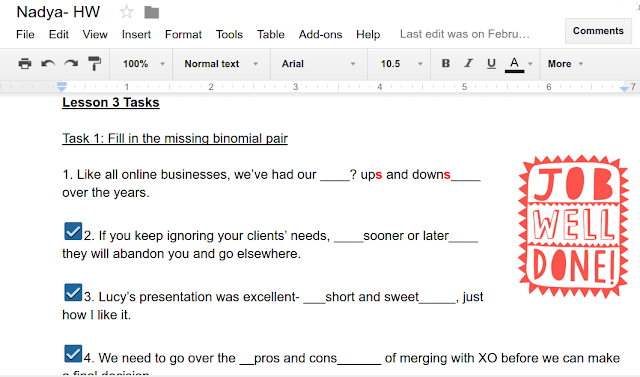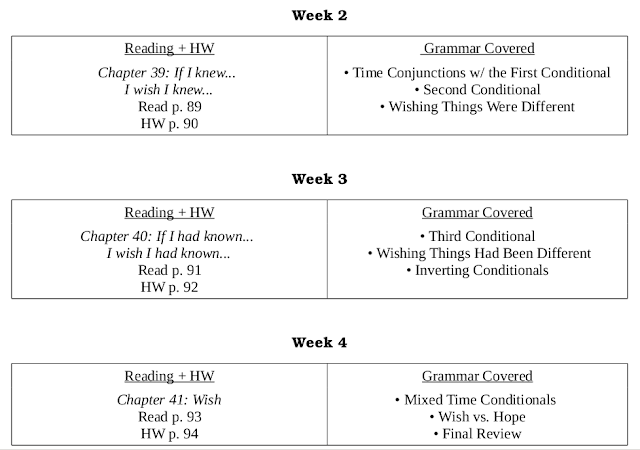Have you ever thought about working for yourself as an online English teacher? It has a lot of perks- you're teaching from home, with interesting people, at a time that works for you. At least, that's how the clichés sell it to you ;) The reality is a mix of the good and the not-so-good (timezone woes, international payment puzzles, lousy Skype connections, etc).
I jumped into the field last March, when a Ukrainian friend asked for Business English lessons. Within a few months, she had found a hotel job in Egypt and the next student appeared. This student was again from Ukraine and a digital nomad to boot. We worked together throughout the summer and I decided to get more serious about this line of work in the fall.
Here's a breakdown of the four courses I taught, what worked, what didn't work, and how things stand now.
Course #1: Sept-Oct 2015
For September, I decided to organize my one-on-one lessons into a formal 4-week course. The first course was on jobs.
Looking back at this, I cringe. The course had good intentions but it took way too long to create and I didn't communicate clearly with the students on exactly what they should do.
The course had so many different components- watch this video! study these words on memrise! write about this topic! listen to this! here's a slideshow! and now we'll Skype! - which led to complete student and teacher overload.
The biggest failures from this course were probably the side vk.com discussion group (totally bombed) and creating YouTube videos with me explaining things in front of the camera (ughh).
Still, it felt really exciting to be attempting this, and it was rewarding enough to try to do it all better in another course.
Course #2: Nov-Dec 2015
This course was pretty much the same as the first one: way too ambitious.
There were some improvements from the first course.
- YouTube videos went better when I showed cards on a desk rather than my face.
- We didn't need a group on social media since students were getting individual material and lessons. This whole "group" thing confused them since they never met any of the other students. I finally dropped the whole "group" idea and started using "course" instead.
- I switched from a free account at memrise to a paid account at quizlet. The students would log in (in theory, haha) and practice with each week's vocab.
Another challenge during this period was taking on a beginner student. One of the hardest parts of teaching is saying "no" to people. I should have done so in this case, but I liked the student and really wanted to help him. I warned him that the material would be i plus ten instead of i plus one, and he amazingly chose to continue after the first week. This poor guy valiantly struggled through things like New York Times articles, imagine!
After this course finished, D and I were out of town for a while. Students were asking about another course- and I did want to continue working with them- but something had to change. I felt like these lessons were failing all of us. Were they actually learning? Could these lessons be reused or were they absurdly time-expensive, one-shot affairs?
Course #3: Jan-Feb 2016
At this point I was craving less prep time and more time to focus on each student's needs. I didn't want to go crazy creating material and be exhausted by the time the course started. It was time for some smart changes! Here are the things that helped:
1. Assign each student a single Google doc for all homework. Put week 1's assignment at the bottom, week 4's assignment at the top.
2. Get rid of the slideshows, YouTube videos, quizlet, etc.
3. Choose a textbook to work from. I adapted a chapter on business meetings from a textbook called Business Vocabulary in Use.
4. USE AN ONLINE WHITEBOARD. This changed everything!!! Before this, we would use Skype's chat window or an open Google doc. The whiteboard let us use more pictures, do matching / fill-in-the-blank activities, move sticky notes around, and have our material in a permanent place. It also felt more professional.
5. Simplify the lessons. I would always end up with extra material. This was a big clue that a lesson didn't need nine activities- better to just pick four good ones and not have to rush.
6. Create a novice course. That brave beginner from Course #2 stuck around and I picked up another beginner. (Of course, I made the mistake of not working from a textbook with them. "Oh, I'll just take these '100 Common English Verbs' and divide them into 4 sections. And create a general topic for each week. And related activities. And...".)
Seriously, that online whiteboard was a SAVIOUR! It looks kind of messy and chaotic now that the boards have been used, but it made the lessons fun again. There are so many possibilities when you're working with a board like this.
Course #4: March 2016
With those new tricks up my sleeve, it was much easier to prepare for the next course. This time we veered away from "general topic" lessons, experimenting instead with grammar. The advanced students had a course on conditional forms.
Seven months in, and I was finally getting to a point where things flowed! Each lesson would focus on a certain conditional tense (or tenses). We'd start with some review-
- go over new material, and then finish up with a review-
At the same time, I had one returning beginner. We worked together on articles, often getting inspiration from one of Betty Azar's textbooks. It was fun, and we got about 1/2 through the chapter in the four weeks we worked together.
Present day
At the end of March, I accepted a part-time job working for someone else (a company) in the English language learning field. All lessons have gone on hold since then. I'm not sure how I feel about returning to teaching online. The biggest issue is the timezone one. Most of the students live in Ukraine and Russia, so 6 PM / 7 PM / 8 PM / 9 PM for them is 8 AM / 9 AM / 10 AM / 11 AM here... and that puts a rather effective cap on the number of people I could work with in one-on-one lessons.
Talking about money, it wasn't a job that paid all the bills. Depending on how often we met, each student would pay $50 or $100 for a 4-week-course. On my end, that was one 50-minute lesson (or two), prep work, + homework corrections. On my taxes for 2015, I think the earnings for the first two courses were about $800. Not exactly what all those "make bank in 60 days!" websites are promising ;) But it was enjoyable work, and I wanted to keep the rates affordable for my students. If I had to support myself from teaching online, it would be tough. I'd probably branch into other time zones, and offer fancier packages with higher rates.
Lessons learned
- You cannot create a course and teach it at the same time. Really bad idea.
- Use something like surveymonkey to create a free, short (reusable!) intake form. Bonus points for making an end-of-course feedback form.
- I mailed my new students welcome postcards and they loved it. The downside is that it was $1 to mail each card and could take over a month to arrive to their home.
- Do payment in advance. I trust all of my students, but the policy was always "first week is a trial, pay by that Sunday to continue in the course".
- Referrals are gold and if you provide value, you'll get them. Everyone knows someone who wants to improve their English / Spanish / whatever. I didn't work for an online school and I didn't advertise at all. All of my students were either previous students (in Ukraine) or referrals from current students.
- The time zone thing, ugh! What a pain! If you're working with people 10 or 11 hours ahead, there really aren't that many convenient times to call each other. And that whole Daylight Savings Time thing, which doesn't happen at the same time in all places, can definitely mess your schedule up. If I remember correctly, last fall the US changed clocks, Ukraine switched things up a few weeks later, and Russia blew off the whole thing, making "what time are we meeting at this week?" an ugly question. This website was the only thing that got us through it.
Was it worth it?
I had a great time working with my students, but I don't see this as a viable lifestyle. I never earned enough to support myself fully. There are probably ways around this (talking about you, time zones!), but if I continue teaching in the fall, it'll most likely be as a supplement to the work I'm doing now.
There really is a lot of freedom and fun that comes along with being your own boss. I liked setting my own schedule (Tues, Weds, Thurs, Sat mornings) and getting to create entire courses on my own. Sometimes I'd have no idea where to start, and I'd turn to teaching stars like Kerstin Cable and Elena Mutonono. In September, I took Kerstin's Online Teaching Live Lesson Strategies For Teachers & Tutors. That helped me get through things like Terms & Conditions and set concrete goals. Elena- who is actually from Ukraine!- has a super helpful blog on things like free trial lessons and designing online courses.



















This is great! I have an interview for a company to do online teaching, but I love this. I also really struggle with tutoring in general so this gave me some ideas! I don't know why I'm so bad at tutoring haha
ReplyDeleteGood luck with the interview! Is the company based in RU or elsewhere?
DeleteIt's with English First. I think most of the students are from China though.
DeleteAh, yeah! I had an interview with them before for teaching in Russia (not online though). It was an awkward Skype call with this girl somewhere in China. She was in a huge call center and kept talking about how hot it was there. They offered a job in a city that D really didn't want to move to, so that was the end of that. Hope you'll share a little about your experience on your blog someday, Jasilyn!
DeleteThanks for sharing your experience so honestly! It's interesting to see what worked and what didn't and what you learnt from each iteration. When I tried italki quite some time ago, I also struggled with the fact lessons were time intensive. Making a course does make much more sense.
ReplyDeleteIt's interesting to think about, even if we have other work right now, as I'm sure there will be a rise in demand from students to learn online.
Cảm ơn, Ruth Elisabeth! I agree with you on the rise of internet lessons. I still really prefer teaching in person, but...
DeleteHow are things going for you with work + language lessons now? I've been reading some posts of UK citizens teaching English elsewhere in the E.U. and how Brexit will affect their work opportunities. Hope things are going well for you!
very inspiring post it is very helpful to us thanks for sharing this information to us keep it up
ReplyDeletehttps://ontesol.com/teach-english-online/